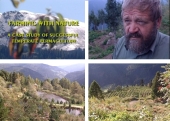posted 11 years ago
Hello and welcome to the forums Mr. Weiss,
First, the pond questions:
I'm in central Arizona here and I'm constructing a small (roughly about 20'x8') pond that I plan to be 7ft deep in the center. The first question I have is what will be the best way to seal it with a gley method; I was thinking about using pigs like Sepp has done, but I heard that they can take nearly 6 months to seal a pond and I want to get it sealed at least within a few weeks to focus some monsoon rains to the pond. Though, since my pond is fairly small do you think that using pigs would be much quicker? Also, could ducks or goats possibly replace the pigs for this? I'll need some ducks to aerate the pond a bit once it's established anyway and I already have goats.
Then, the hugelkultur question:
What do you think of making a hugelkultur mound/dirt mound/woody bed 7' downhill from my swale berms so as to better protect my trees and make a slightly cooler micro climate? Could there be drawbacks to this? I have already constructed three swales on my land and I'm not sure what to do with all the extra dirt from the pond that I've gotten thus far, so for now it's just piled up around the area for the pond.
11.5" precipitation
Soil: clay and gravely clay
Climate: arid desert








